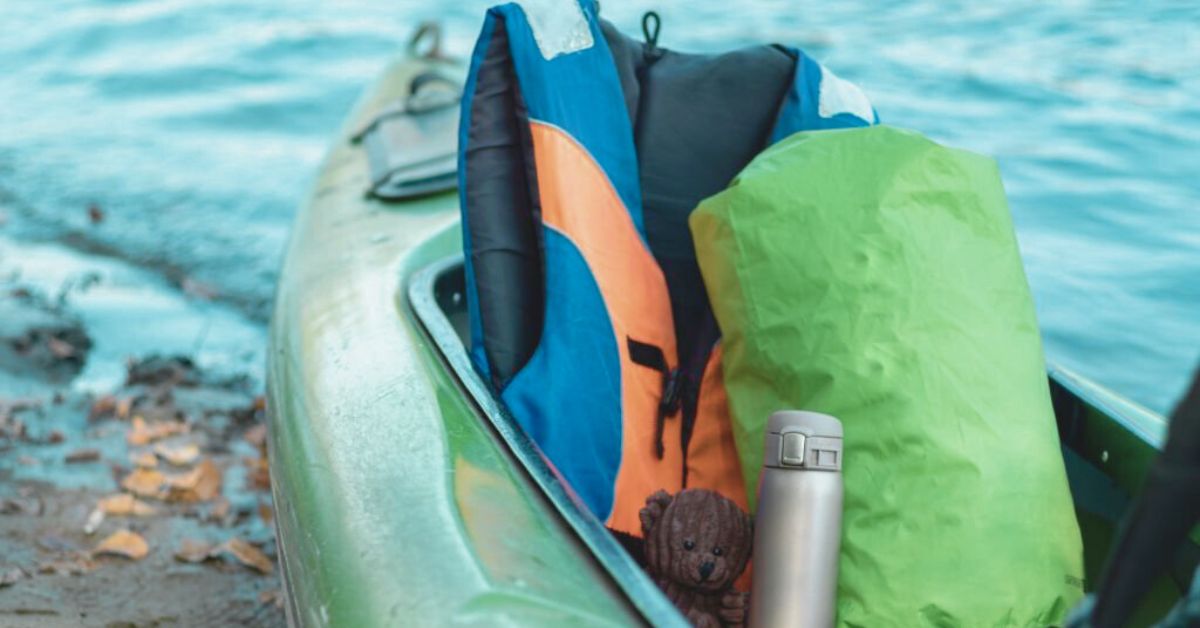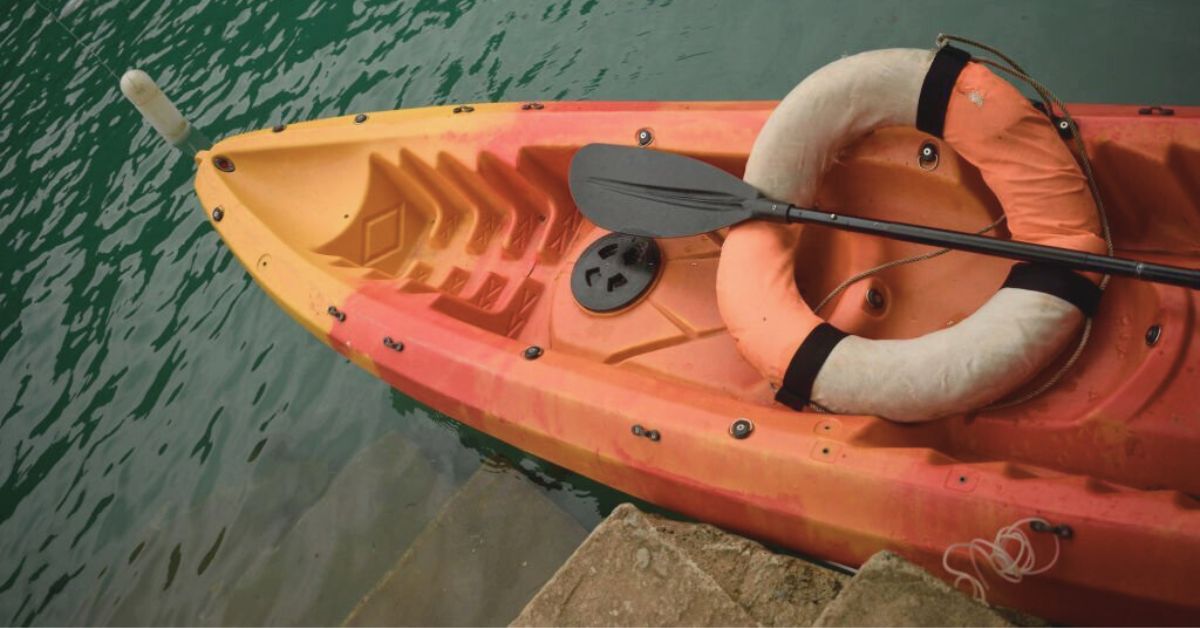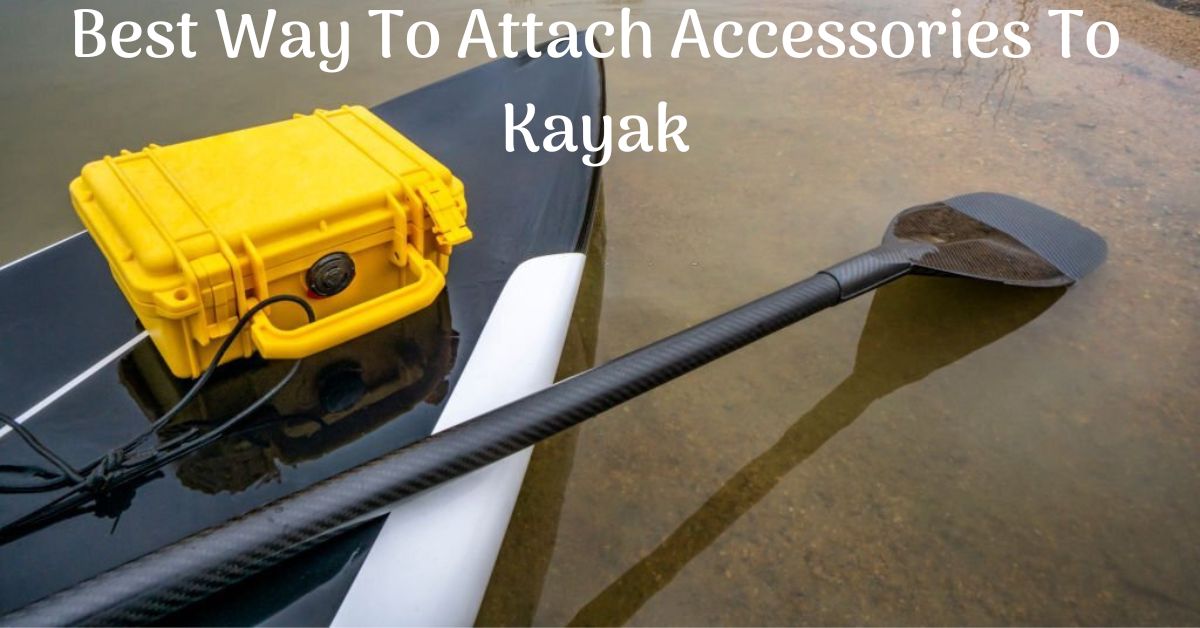Kayaking is a popular pastime for outdoor enthusiasts who like rivers and environment. If you kayak, you know that the appropriate gear can make all the difference.
Kayaking requires accessory attachments to equip your kayak for safety and fun. Figure out which accessories to attach and how to do it safely and quickly might be intimidating.
Everything concerning kayak accessory attachment is covered in this blog article. We’ll help Best Way To Attach Accessories To Kayak. Prepare to elevate your kayaking experience with our Kayak Accessory Attachment 101 tutorial.
Table of Contents
1. Introduction to kayak accessory attachments
As a kayaker, you know that the appropriate gear improves your experience. Whether you’re an angler, photographer, or nature lover, there are several kayak accessories to make it more useful and entertaining.
This section covers kayak accessory attachment fundamentals and how they may increase your time on the water. The options for kayak customization are infinite, from rod holders and fish finders to camera mounts and storage solutions.
Understanding attachment choices and how to safely and effectively install them is the key to equipping your kayak with extras. Track systems, gear tracks, and mounting brackets will be discussed, along with recommendations on choosing the correct attachments for your kayak type.
2. Essential kayak accessories for versatility
The appropriate kayaking gear may improve your experience. A variable setup may make all the difference for experienced or beginner paddlers. These kayak attachments are crucial for a well-equipped and versatile kayak.
• A paddle holder is essential for storing your paddle while not in use. This frees your hands for fishing or photography. Find paddle holders that are simple to install and fit various sizes.
• Rod Holders: Kayak fishing requires rod holders. They keep your fishing rod tight and accessible, letting you concentrate on paddling or navigating. Choose holders that can be moved on your kayak.
• Investment in storage solutions is vital for kayaks due to their limited storage capacity. Dry bags or waterproof containers are ideal for storing items. Deck bags or mesh pockets may also hold sunscreen, food, and water bottles.
• Anchors: For fishing or relaxing, an anchor is a useful addition. Look for lightweight, compact anchor systems that are simple to deploy and recover without adding weight to your kayak.
• Safety Gear: Kayaking safety is paramount. PFDs, whistles, bilge pumps, and first aid kits are essential safety gear. These things are essential for water safety and readiness.
Choosing accessories that match your requirements and hobbies is the key to a varied setup. Consider your kayaking style, surroundings, and preferences. These essential kayak accessories will prepare you for any trip and maximize your time on the water.
3. Selecting the correct kayak attachment technique
Choosing the appropriate connection technique for kayak attachments is vital for security and efficiency.
Different attachment techniques have merits and downsides. Let’s examine some common choices to assist you decide.

1. Bungee Cord
A frequent attaching technique is bungee cords. This includes attaching kayak equipment using elastic cords and hooks or clips.
Bungee cords’ flexibility and simplicity of usage let you swiftly connect or remove anything. In choppy seas or during vigorous maneuvers, they may not be as secure as other ways.
2. System for mounting tracks
Track mounting is another typical attachment technique. This entails adding kayak tracks or rails to glide and secure items using track mounts.
Its adaptability enables for simple modification and relocation of items along the track. It’s vital to follow instructions and seal your kayak properly since the first installation may need drilling.
3. Adhesive Mounts
For non-invasive mounting, sticky mounts are an alternative. Strong adhesive pads or tapes fasten accessories to kayaks using these attachments.
Adhesive mounts are straightforward to install but may fail in harsh situations. Choose marine-specific adhesive mounts for quality.
4. Screw-on Mounting
Screw-in mounts are secure and permanent. You must drill holes in your kayak and screw or bolt accessories to these mounts.
This approach provides good stability and security, although it may not work for kayaks made of particular materials or those who constantly change accessories.
Your kayak’s best attachment technique depends on your requirements and preferences. Consider your kayak, accessories, and security needs. To determine the correct connection technique for a safe and efficient kayak setup, contact the manufacturer and experienced kayakers.
4. Understanding the different types of attachment points
Understanding connection points is essential when adding kayak equipment. These connection points hold and organize gear, improving your kayaking experience.
The most frequent kayak attachments are:
1. D-rings: Kayak hulls and decks have these tiny, robust metal rings. D-rings can connect kayak seats, gear packs, and safety gear. Webbing or bungee cords strengthen them.
2. Slide tracks: Often called gear tracks or mounting rails, are horizontal grooves in the kayak deck. They enable compatible track-mounted systems to easily and adjustably attach extras. This connection point allows extras to be placed along the track.
3. Paddle/Pole Holders: These kayak side attachment points secure paddles or fishing poles. Molded or adjustable clips hold your paddle or pole firmly, making them simple to access while paddling.
4. Bungee Cord Systems: Many kayaks include deck rigging or deck lines. Elastic cords are put through kayak deck connection points to secure stuff like dry bags, water bottles, and replacement paddles. Bungee cords’ elasticity allows them to secure goods of various sizes and forms.
5. Mounting Plates: Some kayaks include mounting plates on the gear tracks or cockpit. Fish finders, GPS devices, and camera attachments are more secure with these plates. Mounting plates contain pre-drilled holes or threaded inserts for convenient installation.
Knowing the various connection points will help you pick the proper accessories and set up your kayak securely and efficiently. Consider your kayaking demands and choose accessories that fit your kayak’s attachment points. A well-equipped and arranged kayak can give you confidence for your next excursion.
5. Instructions for properly mounting kayak accessories
Securing kayak attachments is essential for safety and fun. Follow this step-by-step tutorial to secure your kayak accessories for your next expedition.
Step 1: Assess your kayak first
Before adding attachments, inspect your kayak. Find places to attach extras, such as the front and back deck, side rails, or cockpit. Know your kayak’s structure to find the optimal connection spots for each item.
Step 2: Get tools
A few simple tools are needed to securely connect accessories. Depending on the attachments, they may include adjustable straps, bungee cords, carabiners, mounting brackets, screws, or bolts. Make sure you have the right tools before attaching.
Step 3: Select an attachment method
Choose the right connection method for the accessory. Some additions need drilling holes and screws or bolts, while others may be connected using adjustable straps or bungee cords. Choosing the correct attachment technique ensures a secure fit without damaging your kayak.
Step 4: Put the accessories
Place the item carefully on your kayak. Consider weight distribution, balance, and accessibility. Make sure the item doesn’t hinder paddling or kayak stability.
Step 5: Secure the attachment.
Securely connect the item to your kayak using the specified technique. Tighten all straps, cables, and screws following the manufacturer’s directions. Check the attachment to ensure it won’t fall off while kayaking.
Step 6: Verify stability
Give the item a slight pull or shake to evaluate its stability. It should stay put without moving. If the attachment moves, adjust or tighten the bolts until the item is firmly attached to your kayak.
Step 7: Repeat for accessories.
Repeat the following procedures to connect various accessories. Make sure each equipment is firmly secured to improve your kayaking experience.
This step-by-step instruction will securely connect attachments to your kayak, improving its utility and water pleasure. Regularly check and maintain your attachments to guarantee their safety and durability for future travels.
6. Tips for organizing kayak accessories
Maximizing your kayaking experience requires organizing and arranging gear. A well-organized kayak keeps your stuff on hand and helps you stay balanced.

Tips to properly decorate your kayak with accessories:
• Before starting, determine the kayaking gear you need. These may include paddle holders, rod holders, safety kits, dry bags, and GPS devices. Prioritizing these requirements can help you allot space and assure their availability.
• Most kayaks include storage compartments and hatches for stowing smaller goods. Store sunscreen, food, extra batteries, and other kayaking essentials in these places.
• Attachments like bungee cords or D-rings are strategically placed on kayaks to secure extras. Use these connection points to tie a cooler or tackle box to your kayak. This prevents them from moving or sliding off during paddling.
• Proper weight distribution is essential for stability and mobility. Put heavier stuff like a cooler or fishing gear in the kayak’s middle for proper weight distribution. This will keep your kayak balanced and avoid top-heavy.
• Securing unsecured goods prevents accessories from going overboard or becoming misplaced. Water bottles, fishing nets, and dry bags may be attached to your kayak using bungee cords, carabiners, or straps. This will offer security and peace of mind to your kayaking trips.
• try and adjust: After arranging your attachments, try your kayak. Check how the kayak handles the gear. To achieve balance and comfort, adjust accessories as needed.
Follow these recommendations to organize and arrange kayak gear for a well-equipped and efficient paddling experience. Remember that a well-organized kayak improves functionality and assures a safe, pleasurable ride.
7. Safety considerations when decking out your kayak
When adding kayak accessories, safety should come first. While adding utility and convenience to your kayak is thrilling, it’s crucial to maintain your safety on the water.
Weight distribution of accessories is important for safety. Too numerous or heavy attachments might damage your kayak’s stability and maneuverability, causing capsizing or control issues. Each accessory’s weight and balance must be carefully assessed before installation.

The location of gear is also important for kayaking safety. Make sure the attachments don’t block your paddling or kayak entry or exit. Accessories that might snag or entangle your gear, paddle, or fishing lines can be dangerous.
Also consider attachment materials and structure. Choose high-quality, durable kayaking accessories. Secure, dependable mounting methods and hardware should withstand corrosion and weathering.
Visibility is another safety factor. Attach and display lights, reflectors, and flags to other boats. These safety features improve visibility, particularly in low-light or high-traffic circumstances, decreasing crashes.
Finally, consider how your accessory attachments may affect your kayak’s stability and performance. After making any adjustments, evaluate your kayak’s handling and balance. This lets you make any required modifications to keep your kayak steady and secure.
When adding accessories to your kayak, prioritize safety to enjoy the increased utility and convenience without sacrificing your safety. Remember that a safe and secure kayak setup increases your kayaking experience and lets you appreciate the outdoors.
8. Cleaning and maintaining kayak accessories
Once you have all the kayak accessories, you must prioritize maintenance and upkeep to maintain their life and best operation. Neglecting this might cause premature wear and safety issues when kayaking. Maintaining kayak attachments requires these tips:
1. Cleaning: Always clean your kayaking gear after each trip. Clean accessories with mild soap or specialist cleaners for their materials. Before keeping, rinse them with fresh water to eliminate salt and dirt and air-dry them.
2. Cracks, loose pieces, and worn parts: Should be checked regularly in accessories, This involves examining straps, buckles, attaching mechanisms, and other fasteners. Fix concerns immediately to avoid damage or accidents.
3. Lubrication: Kayak rod holders and hinges may need periodic lubrication to work smoothly. The manufacturer’s instructions will specify the lubrication and application procedure for each attachment.
4. Storage: Kayak attachments need proper storage to last. Keep them out of direct sunlight, severe temperatures, and humidity in a dry, well-ventilated place. Protecting them in cushioned containers or bags during transit or storage may also avoid scratches.
5. UV Protection: Sunlight fades, degrades, and weakens materials. When not in use or stored, protect kayak attachments from UV radiation using UV sprays or covers.
6. Secure Attachments: Before each kayaking journey, verify that all accessories are firmly secured. Tightening straps, buckles, and fasteners prevents inadvertent separation on the water. Also, check rudders and skegs for appropriate operation.
Following these maintenance and care instructions may prolong the life of your kayak gear and make paddling easier. Remember that regular maintenance assures longevity, safety, and water fun.
9. Must-have kayak accessories for different types of activities
The correct kayaking gear may make your trips more pleasurable. Certain kayaking gear are essential depending on the sport.
A comfortable kayak seat, a paddle leash to keep your paddle from floating, and a dry bag to keep your possessions dry are important for recreational kayaking. Exploring calm lakes or rivers with these gear is pleasant and easy.
Several fishing gadgets might enhance your experience. A fishing rod holder lets you keep your hands free while waiting for a bite, and a kayak anchor system keeps you still as you throw. A tackle box or gear storage container helps organize and make fishing gear accessible.
Whitewater kayaking is an adrenaline rush, therefore safety is paramount. A solid kayak helmet and a strong rescue throw bag are needed for emergency protection and aid. Thigh braces also improve control and stability in difficult rapids.
When kayaking or camping overnight, the appropriate gear may make all the difference. A kayak cart or trolley saves your back by transporting your kayak from your car to the ocean. A waterproof kayak deck bag or hatch cover lets you carry additional gear, food, and water.
Remember that your kayaking accessories depend on your interests and hobbies. When choosing kayak accessories, consider your requirements and emphasize safety, comfort, and convenience. Having the appropriate kayak accessories lets you go on excursions and maximize your time on the water.
10. Conclusion
Finally, adding the correct accessories to your kayak may improve your experience. Secure and arrange your kayak equipment for a successful and pleasurable voyage, whether you’re a beginner or an experienced kayaker.
Always put safety first. Attachments and changes should not affect your kayak’s stability or maneuverability. Distributing weight appropriately and not overloading your kayak might impair its performance and put you at danger.
Second, buy good attachments and gear. Find corrosion-resistant, robust materials that can survive water harshness. Choose durable mounting and securing systems to keep your accessories safe in harsh seas or hard movements.
Additionally, examine your kayaking requirements. For convenient fishing gear access, install rod holders and tackle storage sections. For longer excursions, use waterproof storage containers or dry bags to protect your belongings. Customize your accessories to your kayaking style.
Finally, remember upkeep. Check your attachments for security regularly. To avoid corrosion and damage, rinse off seawater and dirt after each expedition. Taking care of your equipment can extend their lives and make kayaking easier.
Follow these steps to turn your kayak into a completely customized watercraft that matches all your demands. Whether you’re fishing or paddling, a well-equipped kayak will make your vacation unforgettable. Explore new seas and enjoy the freedom and thrill of a fully equipped kayak!
